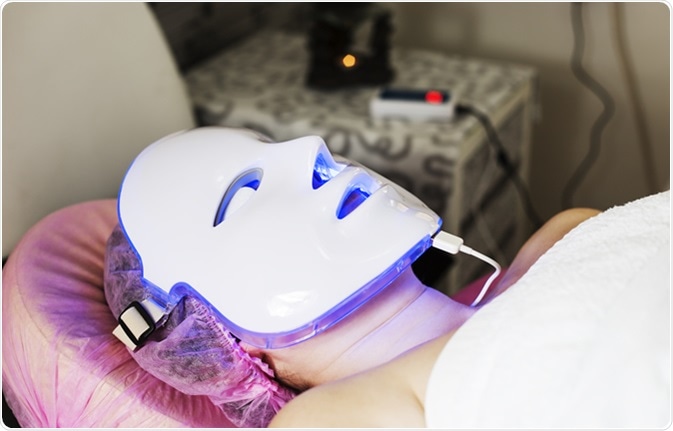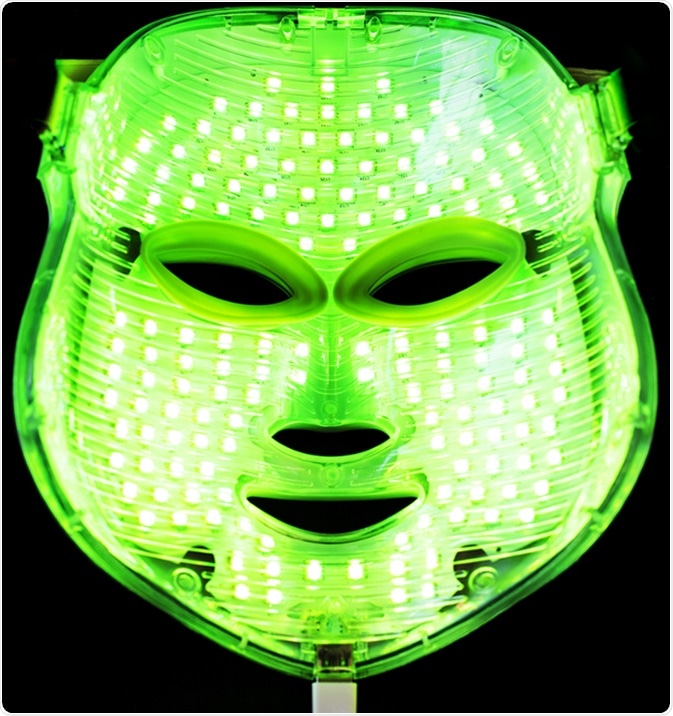LEDs or light emitting diodes are semiconductor devices that release light, of different wavelengths, when an electric current passes through. LED phototherapy is a non-invasive and non-thermal procedure, involving the use of LEDs for a range of medical and aesthetic uses.
LED therapy has been employed to treat a multitude of skin conditions, such as acne vulgaris, psoriasis, keratosis, precancerous tissue and healing of wounds. It is also a popular method for skin rejuvenation, and is widely used by practicing dermatologists. LED phototherapy can be used as a stand-alone therapy or it can be combined with other therapies like peels and micro-needling to combat a variety of skin conditions.
Each wavelength of light penetrates a specific depth of skin tissue, and hence different wavelengths of lights can be used to treat different conditions. Wavelengths of light with therapeutic applications include red (633 nm) and blue (415 nm). The blue is especially helpful in the treatment of acne, whereas the red light is used in skin rejuvenation procedures. Other lights of interest include purple light, which acts as a powerful anti-acne and anti-aging agent; whereas, yellow light has been observed to stimulate lymphatic circulation, and green light to control hyperpigmentation.

What are the Applications of the LED Therapy?
Mild-to-moderate acne vulgaris
Studies have demonstrated that blue light destroys the cell membrane of Propionibacterium acnes (P. acnes), which is the bacteria responsible for acne. Porphyrins, the main metabolic product of these bacteria, are targeted and an endogenous photodynamic process causes the formation of free radicals from these porphyrins. These radicals ultimately destroy the bacterial cell membrane.
Phototherapy in wound healing
LED therapy has been shown to accelerate wound healing. The therapy improves tissue quality after various cosmetic and medical procedures by promoting blood circulation and various anti-inflammatory processes. It also helps in the synthesis and realignment of collagen fibers, which in turn promotes wound healing.
Psoriasis
Studies have demonstrated benefits of phototherapy for the treatment of psoriasis, especially recalcitrant psoriasis. The chemical called protoporphyrin, which accumulates in psoriasis, acts as the photosensitizer or light sensitive molecule. Patients have reported satisfaction with the therapy in various randomized trials.
Photodynamic therapy (PDT)
PDT involves the use of red and blue LEDs to activate certain photosensitizers like 5-aminolevulinic acid (ALA). The process results in the formation of cytotoxic free radicals, which destroy the cells, and thus help in the treatment of cancerous skin lesions.
Skin rejuvenation
LED therapy can be used to rejuvenate the skin and improve one’s aesthetic appearance. The effects are produced by the process of photo-biomodulation, which sensitizes the chromophores to initiate various photochemical pathways. The process results in the synthesis of collagen fibers and proliferation of fibroblasts, which result in skin tightening, and reduction of wrinkles.
What are the Advantages of LED Therapy?
LED phototherapy presents as a safe therapy compared to other thermal based dermatological therapies utilizing ultrasound and radiofrequency. They do not cause thermal injuries, and hence safeguard the epidermal and dermal layers of the skin.
It is also a noninvasive or painless treatment, and patients do not complain of any redness or swelling with the treatment.

Why is the Use of LED Therapy Promising?
LED phototherapy can be used for a range of skin conditions, and has an excellent safety profile. Dermatologists around the globe treat it as a powerful tool in their armamentarium and have reported success in treating difficult skin conditions, including rashes due to chemotherapy.
The broad utility of LED therapy makes it a promising procedure for a plethora of medical and cosmetic applications. Further research is warranted to explore the power of this therapy in even more diagnostic conditions, which may help benefit the sufferers of dermal abnormalities worldwide.
Sources
- https://www.ncbi.nlm.nih.gov/pmc/articles/PMC5843358/
- https://www.ncbi.nlm.nih.gov/pmc/articles/PMC4479368/
- https://www.ncbi.nlm.nih.gov/pmc/articles/PMC3799034/
- https://www.ncbi.nlm.nih.gov/pubmed/19764893/
Further Reading
- All LED Therapy Content
Last Updated: Jan 14, 2019
Source: Read Full Article
